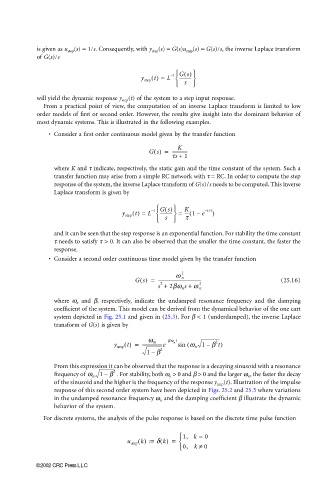Page 809 - The Mechatronics Handbook
P. 809
0066_Frame_C25 Page 8 Wednesday, January 9, 2002 7:05 PM
is given as u step (s) = 1/s. Consequently, with y step (s) = G(s)u step (s) = G(s)/s, the inverse Laplace transform
of G(s)/s
1 Gs()
–
y step t() = L -----------
s
will yield the dynamic response y step (t) of the system to a step input response.
From a practical point of view, the computation of an inverse Laplace transform is limited to low
order models of first or second order. However, the results give insight into the dominant behavior of
most dynamic systems. This is illustrated in the following examples.
• Consider a first order continuous model given by the transfer function
K
Gs() = --------------
ts + 1
where K and τ indicate, respectively, the static gain and the time constant of the system. Such a
transfer function may arise from a simple RC network with τ = RC. In order to compute the step
response of the system, the inverse Laplace transform of G(s)/s needs to be computed. This inverse
Laplace transform is given by
1 Gs()
– K
y step t() = L ----------- = --- 1 e – t/t )
(
–
s t
and it can be seen that the step response is an exponential function. For stability the time constant
τ needs to satisfy τ > 0. It can also be observed that the smaller the time constant, the faster the
response.
• Consider a second order continuous time model given by the transfer function
2
Gs() = --------------------------------------- (25.16)
w n
2
s + 2bw n s + w n 2
where ω n and β, respectively, indicate the undamped resonance frequency and the damping
coefficient of the system. This model can be derived from the dynamical behavior of the one cart
system depicted in Fig. 25.1 and given in (25.3). For β < 1 (underdamped), the inverse Laplace
transform of G(s) is given by
y imp t() = ------------------e – bw t sin ( w n 1 b t)
2
n
w m
–
–
1 b 2
From this expression it can be observed that the response is a decaying sinusoid with a resonance
2
frequency of w n 1 b– . For stability, both ω n > 0 and β > 0 and the larger ω n , the faster the decay
of the sinusoid and the higher is the frequency of the response y imp (t). Illustration of the impulse
response of this second order system have been depicted in Figs. 25.2 and 25.3 where variations
in the undamped resonance frequency ω n and the damping coefficient β illustrate the dynamic
behavior of the system.
For discrete systems, the analysis of the pulse response is based on the discrete time pulse function
1, k = 0
u imp k() := d k() =
0, k ≠ 0
©2002 CRC Press LLC

